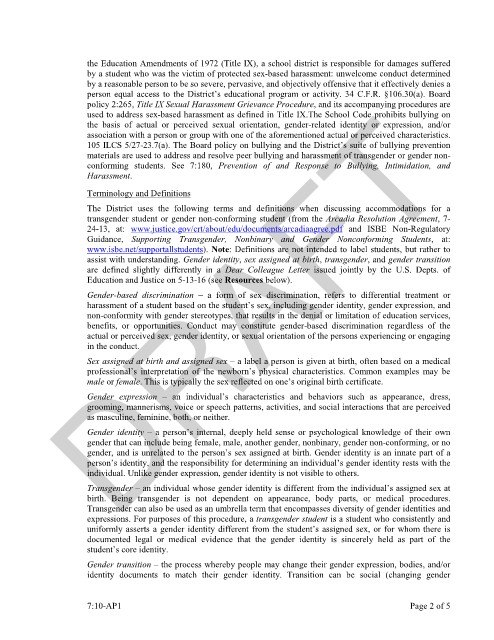Page 1073 - Draft
P. 1073
the Education Amendments of 1972 (Title IX), a school district is responsible for damages suffered
by a student who was the victim of protected sex-based harassment: unwelcome conduct determined
by a reasonable person to be so severe, pervasive, and objectively offensive that it effectively denies a
person equal access to the District’s educational program or activity. 34 C.F.R. §106.30(a). Board
DRAFT
policy 2:265, Title IX Sexual Harassment Grievance Procedure, and its accompanying procedures are
used to address sex-based harassment as defined in Title IX.The School Code prohibits bullying on
the basis of actual or perceived sexual orientation, gender-related identity or expression, and/or
association with a person or group with one of the aforementioned actual or perceived characteristics.
105 ILCS 5/27-23.7(a). The Board policy on bullying and the District’s suite of bullying prevention
materials are used to address and resolve peer bullying and harassment of transgender or gender non-
conforming students. See 7:180, Prevention of and Response to Bullying, Intimidation, and
Harassment.
Terminology and Definitions
The District uses the following terms and definitions when discussing accommodations for a
transgender student or gender non-conforming student (from the Arcadia Resolution Agreement, 7-
24-13, at: www.justice.gov/crt/about/edu/documents/arcadiaagree.pdf and ISBE Non-Regulatory
Guidance, Supporting Transgender, Nonbinary and Gender Nonconforming Students, at:
www.isbe.net/supportallstudents). Note: Definitions are not intended to label students, but rather to
assist with understanding. Gender identity, sex assigned at birth, transgender, and gender transition
are defined slightly differently in a Dear Colleague Letter issued jointly by the U.S. Depts. of
Education and Justice on 5-13-16 (see Resources below).
Gender-based discrimination – a form of sex discrimination, refers to differential treatment or
harassment of a student based on the student’s sex, including gender identity, gender expression, and
non-conformity with gender stereotypes, that results in the denial or limitation of education services,
benefits, or opportunities. Conduct may constitute gender-based discrimination regardless of the
actual or perceived sex, gender identity, or sexual orientation of the persons experiencing or engaging
in the conduct.
Sex assigned at birth and assigned sex – a label a person is given at birth, often based on a medical
professional’s interpretation of the newborn’s physical characteristics. Common examples may be
male or female. This is typically the sex reflected on one’s original birth certificate.
Gender expression – an individual’s characteristics and behaviors such as appearance, dress,
grooming, mannerisms, voice or speech patterns, activities, and social interactions that are perceived
as masculine, feminine, both, or neither.
Gender identity – a person’s internal, deeply held sense or psychological knowledge of their own
gender that can include being female, male, another gender, nonbinary, gender non-conforming, or no
gender, and is unrelated to the person’s sex assigned at birth. Gender identity is an innate part of a
person’s identity, and the responsibility for determining an individual’s gender identity rests with the
individual. Unlike gender expression, gender identity is not visible to others.
Transgender – an individual whose gender identity is different from the individual’s assigned sex at
birth. Being transgender is not dependent on appearance, body parts, or medical procedures.
Transgender can also be used as an umbrella term that encompasses diversity of gender identities and
expressions. For purposes of this procedure, a transgender student is a student who consistently and
uniformly asserts a gender identity different from the student’s assigned sex, or for whom there is
documented legal or medical evidence that the gender identity is sincerely held as part of the
student’s core identity.
Gender transition – the process whereby people may change their gender expression, bodies, and/or
identity documents to match their gender identity. Transition can be social (changing gender
7:10-AP1 Page 2 of 5

